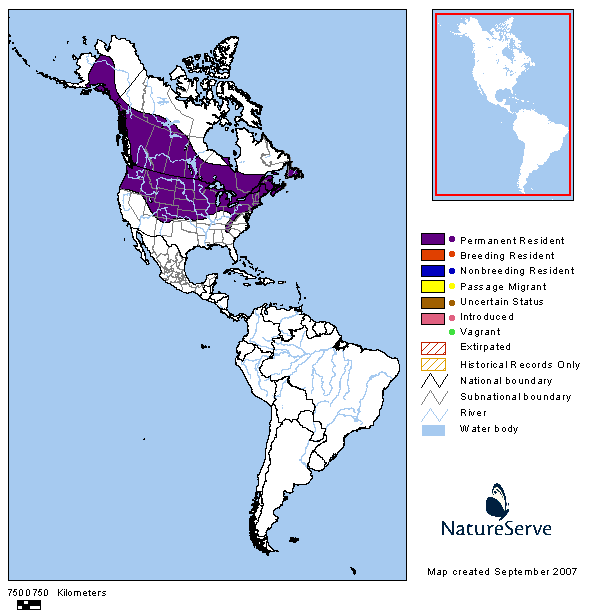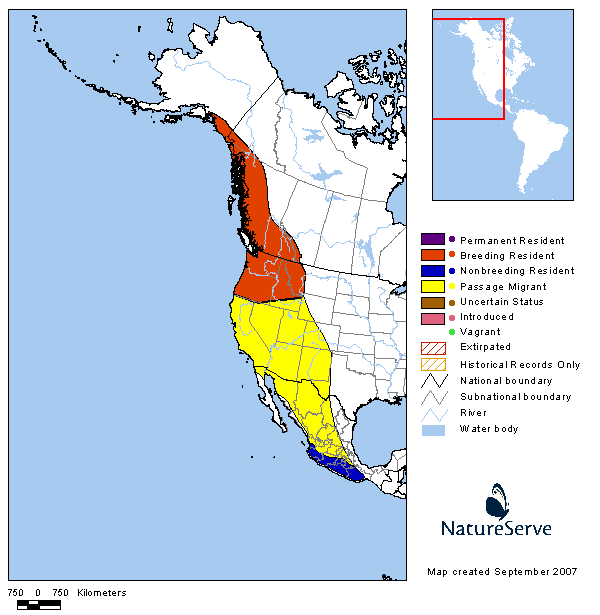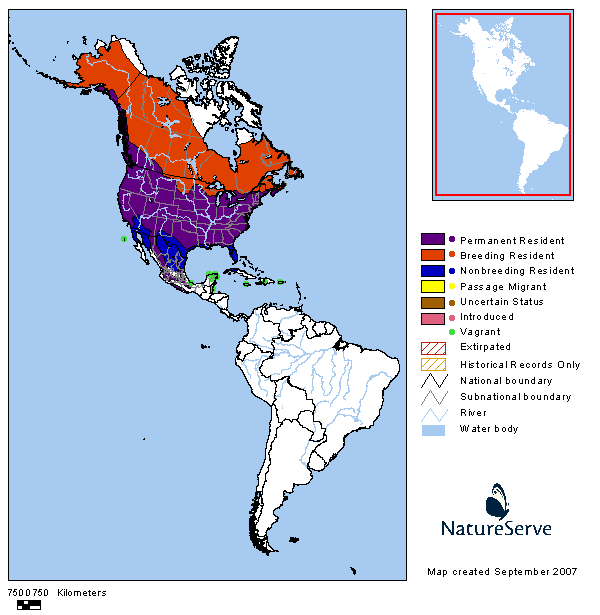Using Range Maps
Range maps encode location and time. Each species has its own map. Location is given by colored areas on a map. Time is indicated by the color of an area.
Some maps discussed below:
Black-capped Chickadee

Rufous Hummingbird

American Robin

Range maps are important aids in identification of species. For example, if you are trying to identify a hummingbird in this area, you may consult a field guide that shows as many as 22 possible species. Since many of the species are quite similar, making an ID might seem next to impossible. However, by consulting the range maps for the species, one would discover that there are only two species that regularly breed here and two more that migrate through the area. 22 possible species have become 4 possible species!
Since range maps tell you about location and time, they provide a window into the migratory nature of a species. Many of the species that breed here in the summer or pass through during the spring and fall migrations make journeys of thousands of miles as they cycle between their breeding and wintering areas each year. Even for species that are present all year, the individuals here in the winter may not be the same ones that are here in the summer.
In the maps used on this site, there are four principal colors:
- Purple: Indicates areas in which individuals of that species are present during every month of the year.
- Blue: Indicates areas which are visited by that species only during the winter months.
- Red: Indicates areas which are used by that species only during the summer breeding season.
- Yellow: Indicates known migration routes. Individuals pass through the area during both spring and fall migrations.
Black-capped Chickadee
(Poecile atricapillus)

Most of the range maps fall into three categories:
1. All purple: In general, species with such a range map spend the whole year in the vicinity of their breeding area. They are mostly non-migratory. The Black-capped Chickadee is such a species. In a study of Canadian 20th Century records, it was found that 90% of individuals showed no movement.1 (See map on right.)
2. Red and blue areas separated by yellow: These species are often "complete migrants". Virtually the entire population deserts its summer breeding range (red) and migrates to a wintering area (blue) that is physically separate from the breeding area. The yellow area depicts the migration path of the migrant. The Rufous Hummingbird, famous for its aggressive domination of hummingbird feeders, is such a migrant. (See map below.)
Rufous Hummingbird
(Selasphorus rufus)

The majority of Rufous Hummingbird individuals migrate northward (springtime) along the west coast.2 Small numbers are recorded in northern NM in the spring, but the majority of the individuals we see come in the southward migration which begins in mid-summer. The Rufous Hummingbirds arrive in our area by the 1st week of July. There will be a steady stream passing through into September.3
3. A northern red (summer breeding) area, a southern blue (wintering) area connected by a purple (All year) area: Species with such a range map are known as "partial migrants". There are individuals present in the purple area during all seasons. However, there are only individuals present in the red area during the summer and the blue area during the winter.
American Robin
(Turdus migratorius)

During the summer months, there is an abundance of food available in the red area. The population that has been compressed into the purple and blue areas in the winter expands into the red breeding area. Once the temperatures begin to drop in the fall, food production declines and the whole population is once again compressed into the purple and blue areas.
The American Robin (see map to right) is one such partial migrant. The individuals that are here in the breeding season are not necessarily the same individuals that are here in the winter. Click here to see monthly eBird maps that clearly depict the seasonal expansions and contractions of the American Robin.
There are many variations on the basic red - purple - blue map. In all cases, they are partial migrants.
Credits:
All Range Maps: Range data provided by Infonatura/Natureserve. Ridgely, R. S., T. F. Alnutt, T. Brooks, D. K. McNicol, D. W. Mehlman, B. E. Young, and J. R. Zook. 2005 Digital Distribution Maps of the Birds of the Western Hemisphere, version 2.1 NatureServe, Arlington, Virginia, USA
Footnotes:
1 Foote, Jennifer R., Daniel J. Mennill, Laurene M. Ratcliffe and Susan M. Smith. 2010. Black-capped Chickadee (Poecile atricapillus), The Birds of North America Online (A. Poole, Ed.). Ithaca: Cornell Lab of Ornithology; Retrieved from the Birds of North America Online: http://bna.birds.cornell.edu/bna/species/039
doi:10.2173/bna.39
2 Healy, Susan and William A. Calder. (2006). Rufous Hummingbird (Selasphorus rufus), The Birds of North America (P. G. Rodewald, Ed.). Ithaca: Cornell Lab of Ornithology; Retrieved from the Birds of North America: https://birdsna.org/Species-Account/bna/species/rufhum DOI: 10.2173/bna.53
3 From consultation of eBird maps. (www.ebird.org)